#dutch pharmaceutical
Text
The Best News of Last Year - 2023 Edition
Welcome to our special edition newsletter recapping the best news from the past year. I've picked one highlight from each month to give you a snapshot of 2023. No frills, just straightforward news that mattered. Let's relive the good stuff that made our year shine.
January - London: Girl with incurable cancer recovers after pioneering treatment
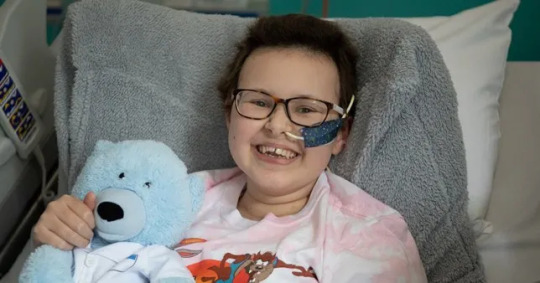
A girl’s incurable cancer has been cleared from her body after what scientists have described as the most sophisticated cell engineering to date.
2. February - Utah legislature unanimously passes ban on LGBTQ conversion therapy

The Utah State Legislature has unanimously approved a bill that enshrines into law a ban on LGBTQ conversion therapy.
3. March - First vaccine for honeybees could save billions

The United States Department of Agriculture (USDA) has approved the world’s first-ever vaccine intended to address the global decline of honeybees. It will help protect honeybees from American foulbrood, a contagious bacterial disease which can destroy entire colonies.
4. April - Fungi discovered that can eat plastic in just 140 days
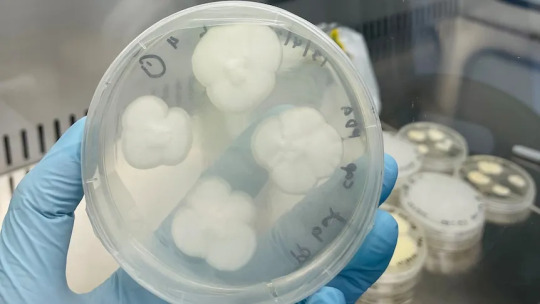
Australian scientists have successfully used backyard mould to break down one of the world's most stubborn plastics — a discovery they hope could ease the burden of the global recycling crisis within years.
5. May - Ocean Cleanup removes 200,000th kilogram of plastic from the Pacific Ocean

The Dutch offshore restoration project, Ocean Cleanup, says it has reached a milestone. The organization's plastic catching efforts have now fished more than 200,000 kilograms of plastic out of the Pacific Ocean, Ocean Cleanup said on Twitter.
6. June - U.S. judge blocks Florida ban on care for trans minors in narrow ruling, says ‘gender identity is real’

A federal judge temporarily blocked portions of a new Florida law that bans transgender minors from receiving puberty blockers, ruling Tuesday that the state has no rational basis for denying patients treatment.
7. July - World’s largest Phosphate deposit discovered in Norway

A massive underground deposit of high-grade phosphate rock in Norway, pitched as the world’s largest, is big enough to satisfy world demand for fertilisers, solar panels and electric car batteries over the next 50 years, according to the company exploiting the resource.
8. August - Successful room temperature ambient-pressure magnetic levitation of LK-99

If the claim by Sukbae Lee and Ji-Hoon Kim of South Korea’s Quantum Energy Research Centre holds up, the material could usher in all sorts of technological marvels, such as levitating vehicles and perfectly efficient electrical grids.
9. September - World’s 1st drug to regrow teeth enters clinical trials

The ability to regrow your own teeth could be just around the corner. A team of scientists, led by a Japanese pharmaceutical startup, are getting set to start human trials on a new drug that has successfully grown new teeth in animal test subjects.
10. October - Nobel Prize goes to scientists behind mRNA Covid vaccines

The Nobel Prize in Physiology or Medicine has been awarded to a pair of scientists who developed the technology that led to the mRNA Covid vaccines. Professors Katalin Kariko and Drew Weissman will share the prize.
11. November - No cases of cancer caused by HPV in Norwegian 25-year olds, the first cohort to be mass vaccinated for HPV.
Last year there were zero cases of cervical cancer in the group that was vaccinated in 2009 against the HPV virus, which can cause the cancer in women.
12. December - President Biden announces he’s pardoning all convictions of federal marijuana possession
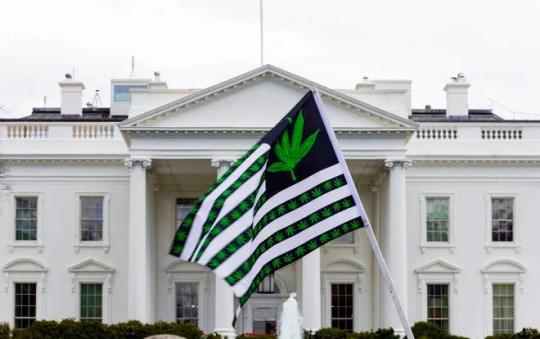
President Joe Biden announced Friday he's issuing a federal pardon to every American who has used marijuana in the past, including those who were never arrested or prosecuted.
------
And there you have it – a year's worth of uplifting news! I hope these positive stories brought a bit of joy to your inbox. As I wrap up this special edition, I want to thank all my supporters!
Buy me a coffee ❤️
Merry Christmas and Happy New Year!
6K notes
·
View notes
Link
Layla Jane is suing Kaiser Permanente for malpractice as a result of her gender transition. She is suing the same organization that Chloe Cole is and they had some of the same doctors. Tragically, Layla Jane has a mastectomy at 13, which she now regrets.
This is a reminder that pediatric transition is a highly experimental procedure with a shockingly poor evidence base. The Dutch Protocol was funded by Ferring Pharmaceuticals, which makes puberty blockers and it has never been successfully replicated. Children who experience gender dysphoria deserve care that is evidence based, not highly experimental and questionable treatments.
#layla jane#chloe cole#detrans#detransistioners#kaiser permanente#trans medical scandal#dutch protocol#ferring pharmaceuticals#puberty blockers#gender affirming care#pediatric transition
0 notes
Text
Because most medicines were produced from [...] plants [...] these early “pharmaceutical monopolies” required full control of the production and trade of a species. Russia successfully managed the rhubarb trade in the seventeenth and eighteenth centuries, while Spain controlled the distribution [...] from Spanish America, mainly cinchona from Peru, in the same period. “True” cinnamon grew only on Sri Lanka, so whoever controlled the island could dominate the cinnamon trade. The Portuguese were the first to create a monopoly on the cinnamon trade there in the early seventeenth century. That monopoly was later optimized by the Dutch in the late eighteenth century [...].
“True” should indeed be in quotation marks here - the term reflects the historically contingent tastes of Europeans, rather than any botanical category [...]. The rarity of cinnamon in the early modern period made it one of the most coveted spices of that era, and European countries without direct access to the cinnamon trade tried to imitate, substitute, steal, smuggle, or transplant the “true” product from Sri Lanka. [...]
---
In the early modern period, cinnamon was also important both as an exotic commodity and as an important therapeutic substance. The Dutch East India Company (VOC), which controlled Sri Lanka between 1658 and 1796, was well aware of this. The VOC vigorously exploited the Salagama - [...] specialized Sri Lankan cinnamon peelers - to supply enough cinnamon, which for a long time was gathered from forests. Only after the peelers rebelled, leading to a war that lasted between 1760 and 1766, did the company revise its production policy.
Experiments with “cinnamon gardens” (kaneeltuinen in Dutch) led to enormous successes, and the company eventually grew millions of cinnamon trees on plantations in the final decades of the eighteenth century. Meanwhile, competitors of the Dutch had come up with their own solutions [...]: Spain had started growing other Cinnamomum species on plantations in the Philippines, while France and Britain succeeded in transplanting cinnamon to islands in the Caribbean. But the Dutch monopoly was not simply threatened by outside competition. Smuggling, by peelers or VOC personnel, was strictly forbidden and severely punished. [...]
---
Hendrik Adriaan van Rheede tot Drakenstein (1636–1691) was the VOC administrator on India’s Malabar Coast when he started experimenting with cinnamon oil in the 1670s.
He concluded that the oil, which he extracted from the roots of local cinnamon trees, was of better quality than oil from cinnamon trees on Sri Lanka. Van Rheede reported these results in his entry on cinnamon in volume 1 of the Hortus Indicus Malabaricus, the twelve-volume book that was produced by a team of local and European scholars, and supervised by Van Rheede himself.
Van Rheede’s assessment of cinnamon - in fact, the very publication of a multi-volume work about the flora of Malabar - infuriated the governor of Sri Lanka, Rijckloff van Goens, who had secured the cinnamon monopoly of Sri Lanka for the Dutch. Van Goens insisted that Van Rheede stop his medical experiments, claiming that the monopoly was at risk if the cinnamon trade was extended beyond the island of Sri Lanka.
But Van Goens was not so much concerned about the therapeutic efficacy of cinnamon from either of the two regions. He was motivated by an imperial agenda and regarded the natural products of Sri Lanka as superior to anything similar in the region.
The experiments of Van Rheede, who was his former protégé, threatened not so much the botanical quality of the product, or the commercial interests of the Dutch East India Company, but rather the central position of Sri Lanka in the Dutch colonial system and the position of Van Goens as the representative of that system.
---
Even when Sri Lanka still only produced cinnamon that grew in the wild, the Dutch harvested enough to supply an international market and were able to dictate the availability and price level throughout the world. The monopoly, whether defined in commercial or pharmaceutical terms, was not easily put at risk by efforts like Van Rheede’s. Those involved in the early modern cinnamon trade were motivated by various reasons to defend or undermine the central position of Sri Lankan cinnamon: botanical, medical, commercial, or imperial. These motives often overlapped.
---
All text above by: Wouter Klein. “Plant of the Month: Cinnamon.” JSTOR Daily. 17 February 2021. “Plant of the Month” series is part of the Plant Humanities Initiative, a partnership of Dumbarton Oaks and JSTOR Labs. [Bold emphasis and some paragraph breaks/contractions added by me. Presented here for commentary, teaching, criticism purposes.]
150 notes
·
View notes
Text
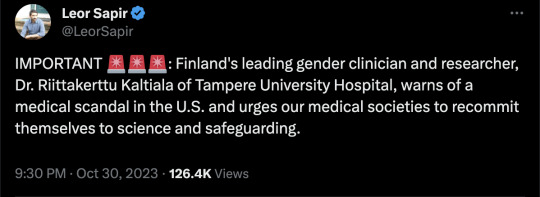
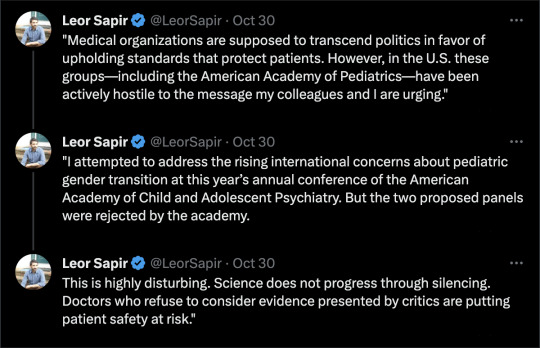
By: Riittakerttu Kaltiala
Published: Oct 30, 2023
Dr. Riittakerttu Kaltiala, 58, is a Finnish-born and trained adolescent psychiatrist, the chief psychiatrist in the department of adolescent psychiatry at Finland’s Tampere University Hospital. She treats patients, teaches medical students, and conducts research in her field—publishing more than 230 scientific articles.
In 2011, Dr. Kaltiala was assigned a new responsibility. She was to oversee the establishment of a gender identity service for minors, making her among the first physicians in the world to head a clinic devoted to the treatment of gender-distressed young people. Since then, she has personally participated in the assessments of more than 500 such adolescents.
Earlier this year, The Free Press ran a whistleblower account by Jamie Reed, a former case manager at The Washington University Transgender Center at St. Louis Children’s Hospital. She recounted her growing alarm at the effects of treatments that sought to transition minors to the opposite sex, and her escalating conviction that patients were being harmed by their treatment.
Although a recent New York Times investigation largely corroborated Reed’s account, many activists and members of the media continue to dismiss Reed’s claims because she is not a physician.
Dr. Kaltiala is. And her concerns are likely to get more attention in the U.S. now that a young woman who medically transitioned as a teenager has just sued the doctors who supervised her treatment, along with the American Academy of Pediatrics. According to the suit, the AAP, in advocating for youth transition, has made “outright fraudulent statements” about evidence for “the radical new treatment model, and the known dangers and potential side effects of the medical interventions it advocates.”
Here, Dr. Kaltiala tells her own story, describing her increasing worries about the treatment she approved for vulnerable patients, and her decision to speak out.
--
Early in my medical studies, I knew I wanted to be a psychiatrist. I decided to specialize in treating adolescents because I was fascinated by the process of young people actively exploring who they are and seeking their role in the world. My patients’ adult lives are still ahead of them, so it can make a huge difference to someone’s future to help a young person who is on a destructive track to find a more favorable course. And there are great rewards in doing individual therapeutic work.
Over the past dozen or so years there has been a dramatic development in my field. A new protocol was announced that called for the social and medical gender transition of children and teenagers who experienced gender dysphoria—that is, a discordance between one’s biological sex and an internal feeling of being a different gender.
This condition has been described for decades, and the 1950s is seen as the beginning of the modern era of transgender medicine. During the twentieth century, and into the twenty-first, small numbers of mostly adult men with lifelong gender distress have been treated with estrogen and surgery to help them live as women. Then in recent years came new research on whether medical transition—primarily hormonal—could be done successfully on minors.
One motivation of the medical professionals overseeing these treatments was to prevent young people from facing the difficulties adult men had experienced in trying to convincingly appear as women. The most prominent advocates of youth transition were a group of Dutch clinicians. They published a breakthrough paper in 2011 establishing that if young people with gender dysphoria were able to avoid their natural puberty by blocking it with pharmaceuticals, followed by receiving opposite-sex hormones, they could start living their transgender lives earlier and more credibly.
It became known as the “Dutch protocol.” The patient population the Dutch doctors described was a small number of young people—almost all male—who, from their earliest years, insisted they were girls. The carefully selected patients, apart from their gender distress, were mentally healthy and high-functioning. The Dutch clinicians reported that following early intervention, these young people thrived as members of the opposite sex. The protocol was quickly adopted internationally as the gold standard treatment in this new field of pediatric gender medicine.
Concurrently, there arose an activist movement that declared gender transition was not just a medical procedure, but a human right. This movement became increasingly high profile, and the activists’ agenda dominated the media coverage of this field. Advocates for transition also understood the power of the emerging technology of social media. In response to all this, in Finland the Ministry of Social Affairs and Health wanted to create a national pediatric gender program. The task was given to the two hospitals that already housed gender identity services for adults. In 2011, my department was tasked with opening this new service, and I as the chief psychiatrist became the head of it.
Even so, I had some serious questions about all this. We were being told to intervene in healthy, functioning bodies simply on the basis of a young person’s shifting feelings about gender. Adolescence is a complex period in which young people are consolidating their personalities, exploring sexual feelings, and becoming independent of their parents. Identity achievement is the outcome of successful adolescent development, not its starting point.
At our hospital, we had a big round of discussions with bioethicists. I expressed my concern that gender transition would interrupt and disrupt this crucial psychological and physical developmental stage. Finally, we obtained a statement from a national board on health ethics cautiously suggesting we undertake this new intervention.
We are a country of 5.5 million with a nationalized healthcare system, and because we required a second opinion to change identity documents and proceed to gender surgery, I have personally met and evaluated the majority of young patients at both clinics considering transition: to date, more than 500 young people. Approval for transition was not automatic. In early years, our psychiatric department agreed to transition for about half of those referred. In recent years, this has dropped to about twenty percent.
As the service got underway starting in 2011, there were many surprises. Not only did the patients come, they came in droves. Around the Western world the numbers of gender-dysphoric children were skyrocketing.
But the ones who came were nothing like what was described by the Dutch. We expected a small number of boys who had persistently declared they were girls. Instead, 90 percent of our patients were girls, mainly 15 to 17 years old, and instead of being high-functioning, the vast majority presented with severe psychiatric conditions.
Some came from families with multiple psychosocial problems. Most of them had challenging early childhoods marked by developmental difficulties, such as extreme temper tantrums and social isolation. Many had academic troubles. It was common for them to have been bullied—but generally not regarding their gender presentation. In adolescence they were lonely and withdrawn. Some were no longer in school, instead spending all their time alone in their room. They had depression and anxiety, some had eating disorders, many engaged in self-harm, a few had experienced psychotic episodes. Many—many—were on the autism spectrum.
Remarkably, few had expressed any gender dysphoria until their sudden announcement of it in adolescence. Now they were coming to us because their parents, usually just mothers, had been told by someone in an LGBT organization that gender identity was their child’s real problem, or the child had seen something online about the benefits of transition.
Even during the first few years of the clinic, gender medicine was becoming rapidly politicized. Few were raising questions about what the activists—who included medical professionals—were saying. And they were saying remarkable things. They asserted that not only would the feelings of gender distress immediately disappear if young people start to medically transition, but also that all their mental health problems would be alleviated by these interventions. Of course, there is no mechanism by which high doses of hormones resolve autism or any other underlying mental health condition.
Because what the Dutch had described differed so dramatically from what I was seeing in our clinic, I thought maybe there was something unusual about our patient population. So I started talking about our observations with a network of professionals in Europe. I found out that everybody was dealing with a similar caseload of girls with multiple psychiatric problems. Colleagues from different countries were confused by this, too. Many said it was a relief to hear their experience was not unique.
But no one was saying anything publicly. There was a feeling of pressure to provide what was supposed to be a wonderful new treatment. I felt in myself, and saw in others, a crisis of confidence. People stopped trusting their own observations about what was happening. We were having doubts about our education, clinical experience, and ability to read and produce scientific evidence.
Soon after our hospital began offering hormonal interventions for these patients, we began to see that the miracle we had been promised was not happening. What we were seeing was just the opposite.
The young people we were treating were not thriving. Instead, their lives were deteriorating. We thought, what is this? Because there wasn’t a hint in studies that this could happen. Sometimes the young people insisted their lives had improved and they were happier. But as a medical doctor, I could see that they were doing worse. They were withdrawing from all social activities. They were not making friends. They were not going to school. We continued to network with colleagues in different countries who said they were seeing the same things.
I became so concerned that I embarked on a study with my Finnish colleagues to describe our patients. We methodically went through the records of those who had been treated at the clinic its first two years, and we characterized how troubled they were—one of them was mute—and how much they differed from the Dutch patients. For example, more than a quarter of our patients were on the autism spectrum. Our study was published in 2015, and I believe it was the first journal publication from a gender clinician raising serious questions about this new treatment.
I knew others were making the same observations at their clinics, and I hoped my paper would spark discussion about their concerns—that’s how medicine corrects itself. But our field, instead of acknowledging the problems we described, became more committed to expanding these treatments.
In the U.S., your first pediatric gender clinic opened in Boston in 2007. Fifteen years later there were more than 100 such clinics. As the U.S. protocols developed, fewer limitations were put on transition. A Reuters investigation found that some U.S. clinics approved hormone treatments at a minor’s first visit. The U.S. pioneered a new treatment standard, called “gender-affirming care,” which urged clinicians simply to accept a child’s assertion of a trans identity, and to stop being “gatekeepers” who raised concerns about transition.
Around 2015, in addition to the very psychiatrically ill patients, a new set of patients started arriving at our clinic. We began to see groups of teenage girls, also usually from 15 to 17 years of age from the same small towns, or even the same schools, telling the same life stories and the same anecdotes about their childhoods, including their sudden realization that they were transgender—despite no prior history of dysphoria. We realized they were networking and exchanging information about how to talk to us. And so, we got our first experience of social contagion–linked gender dysphoria. This, too, was happening in pediatric gender clinics around the world, and again health providers were failing to speak up.
I understood this silence. Anyone, including physicians, researchers, academics, and writers, who raised concerns about the growing power of gender activists, and about the effects of medically transitioning young people, were subjected to organized campaigns of vilification and threats to their careers.
In 2016, because of several years of growing concern about the harms of transition on vulnerable young patients, Finland’s two pediatric gender services changed their protocols. Now, if young people had other, more urgent problems than gender dysphoria that needed to be addressed, we promptly referred those patients for more appropriate treatment, such as psychiatric counseling, rather than continuing their gender identity assessment.
There was a lot of pressure against this approach from activists, politicians, and the media. The Finnish press published stories of young people dissatisfied with our decision, portraying them as victims of gender clinics that were forcing them to put their lives on hold. A Finnish medical journal ran a piece that took the perspective of dissatisfied activists titled, “Why do trans adolescents not get their blockers?”
But I was trained that medical treatment has to be based on medical evidence, and that medicine has to constantly correct itself. When you are a physician who sees something is not working, it is your duty to organize, research, inform your colleagues, inform a big audience, and stop doing that treatment.
Finland’s national healthcare system gives us the ability to investigate current medical practices and set new guidelines. In 2015 I personally asked a national body, called the Council for Choices in Health Care (COHERE), to create national guidelines for treatment of gender dysphoria in minors. In 2018 I renewed this request with colleagues, and it was accepted. COHERE commissioned a systematic evidence review to assess the reliability of the current medical literature on youth transition.
Around this same time, eight years into the opening of the pediatric gender clinic, some previous patients started coming back to tell us they now regretted their transition. Some—called “detransitioners”—wished to return to their birth sex. These were another kind of patient who wasn’t supposed to exist. The authors of the Dutch protocol asserted that rates of regret were miniscule.
But the foundation on which the Dutch protocol was based is crumbling. Researchers have shown that their data had some serious problems, and that in their follow-up, they failed to include many of the very people who may have regretted transition or changed their minds. One of the patients had died due to complications from genital transition surgery.
There is an oft-repeated statistic in the world of pediatric gender medicine that only one percent or less of young people who transition subsequently detransition. The studies asserting this, too, rest on biased questions, inadequate samples, and short timelines. I believe regret is far more widespread. For example, one new study shows that nearly 30 percent of patients in the sample ceased filling their hormone prescription within four years.
Usually, it takes several years for the full impact of transition to settle in. This is when young people who have entered adulthood confront what it means to possibly be sterile, to have damaged sexual function, to have great difficulty in finding romantic partners.
It is devastating to speak to patients who say they were naive and misguided about what transition would mean for them, and who now feel it was a terrible mistake. Mainly these patients tell me they were so convinced they needed to transition that they concealed information or lied in the assessment process.
I continued to research the issue and in 2018, with colleagues, I published another paper, one that investigated the origin of the surging numbers of gender-dysphoric young people. But we didn’t find answers as to why this was happening, or what to do about it. We noted in our study a point that is generally ignored by gender activists. That is, for the overwhelming majority of gender dysphoric children—around 80 percent—their dysphoria resolves itself if they are left to go through natural puberty. Often these children come to realize they are gay.
In June of 2020 a major event happened in my field. Finland’s national medical body, COHERE, released its findings and recommendations regarding youth gender transition. It concluded that the studies touting the success of the “gender-affirming” model were biased and unreliable—systematically so in some cases.
The authors wrote: “In light of available evidence, gender reassignment of minors is an experimental practice.” The report stated that young patients seeking gender transition should be instructed about “the reality of a lifelong commitment to medical therapy, the permanence of the effects, and the possible physical and mental adverse effects of the treatments.” The report warned that young people, whose brains were still maturing, lacked the ability to properly “assess the consequences” of making decisions they would have to live with for the “rest of their lives.”
COHERE also recognized the dangers of giving hormone treatments to young people with serious mental illness. The authors concluded that for all these reasons, gender transition should be postponed “until adulthood.”
It had taken quite a while, but I felt vindicated.
Fortunately, Finland is not alone. After similar reviews, the UK and Sweden have come to similar conclusions. And many other countries with national healthcare systems are re-evaluating their “gender-affirming” stance.
I felt an increasing obligation to patients, to medicine, and to the truth, to speak outside of Finland against the widespread transitioning of gender-distressed minors. I have been particularly concerned about American medical societies, who as a group continue to assert that children know their “authentic” selves, and a child who declares a transgender identity should be affirmed and started on treatment. (In recent years, the “trans” identity has evolved to include more young people who say they are “nonbinary”—that is, they feel they don’t belong to either sex—and other gender variations.)
Medical organizations are supposed to transcend politics in favor of upholding standards that protect patients. However, in the U.S. these groups—including the American Academy of Pediatrics—have been actively hostile to the message my colleagues and I are urging.
I attempted to address the rising international concerns about pediatric gender transition at this year’s annual conference of the American Academy of Child and Adolescent Psychiatry. But the two proposed panels were rejected by the academy. This is highly disturbing. Science does not progress through silencing. Doctors who refuse to consider evidence presented by critics are putting patient safety at risk.
I am also disturbed by how gender clinicians routinely warn American parents that there is an enormously elevated risk of suicide if they stand in the way of their child’s transition. Any young person’s death is a tragedy, but careful research shows that suicide is very rare. It is dishonest and extremely unethical to pressure parents into approving gender medicalization by exaggerating the risk of suicide.
This year the Endocrine Society of the U.S. reiterated its endorsement of hormonal gender transition for young people. The president of the society wrote in a letter to The Wall Street Journal that such care was “lifesaving” and “reduces the risk of suicide.” I was a co-author of a letter in response, signed by 20 clinicians from nine countries, refuting his assertion. We wrote that, “Every systematic review of evidence to date, including one published in the Journal of the Endocrine Society, has found the evidence for mental health benefits of hormonal interventions for minors to be of low or very low certainty.”
Medicine, unfortunately, is not immune to dangerous groupthink that results in patient harm. What is happening to dysphoric children reminds me of the recovered memory craze of the 1980s and ’90s. During that period, many troubled women came to believe false memories, often suggested to them by their therapists, of nonexistent sexual abuse by their fathers or other family members. This abuse, the therapists said, explained everything that was wrong with the lives of their patients. Families were torn apart, and some people were prosecuted based on made-up assertions. It ended when therapists, journalists, and lawyers investigated and exposed what was happening.
We need to learn from such scandals. Because, like recovered memory, gender transition has gotten out of hand. When medical professionals start saying they have one answer that applies everywhere, or that they have a cure for all of life’s pains, that should be a warning to us all that something has gone very wrong.
--
Medicine has become infected by ideology.
#Riittakerttu Kaltiala#gender ideology#queer theory#genderwang#medical transition#medical scandal#gender affirming care#gender affirmation#gender affirming healthcare#medical malpractice#affirm or suicide#gender transition#pediatric gender transition#medical experimentation#religion is a mental illness
14 notes
·
View notes
Text
The Steroid Olympics
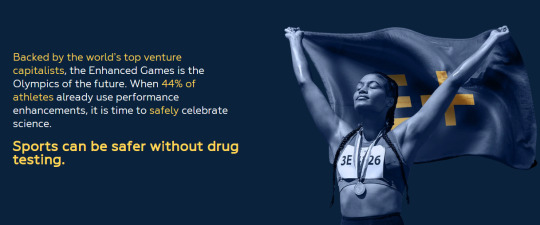
There's been some talk floating around online lately about The Enhanced Games, including an episode of the Trashfuture podcast I'd certainly recommend.
I've become fascinated--not because I'm a right-wing tech-and-immortality fetishist, but rather because of the specific and insidious way the project uses progressive language to hide its true nature. It's evil in a fascinating and specific way that leans on progressive language to do its dirty deeds.
First, I should explain the project. "What if the Olympics let every athlete do as many steroids as they want?" is the basic pitch. Going deeper, it's part of a certain subset of global capital's fascination with what's called here Human Enhancement: the search for immortality and transcendent physical power. It's also, importantly, a project trying to justify itself and in doing so get rid of the stigma around steroid use in sports (notably not the stigma around steroid use in, you know, HRT.) Also it's a for-profit project co-founded by a pharmaceutical CEO whose companies specialize in Human Enhancement fare.
Look at the tiles on the website:


Pay the athletes. Science is real. Enhanced inclusive language. We'll absolutely look deeper, but there's already a very present sense of what a good friend of mind called crypsis.


There's an almost convincing facsimile of progressive language here. But the tiger is lurking in the grass.
Let's enter some of these tiles. See how a camouflaged predator works.

This is immediately insidious. There's a rhetorical conflation between antivaxxers and anyone who opposes to doping here. And remember, this organization is selling the fantasy of "what if athletes juice so hard they were superhuman."
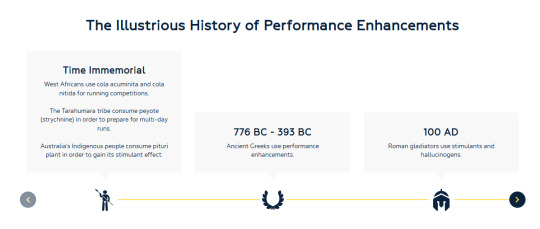
And then we get into the sloppy propaganda-history. It's a lineage more wrenched into place than discovered, and that makes no distinction between war, bloodsport, and sport in a more modern sense.

Bufotenin (not bufotein) is the DMT-anolouge you get from licking toads. Perhaps not the same, conceptually, as anabolic steroid use.
Moving on from the bad history, we have this:
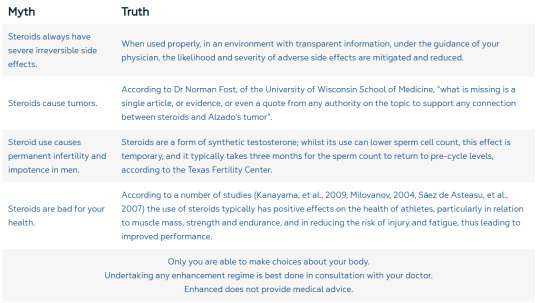
Cherry picking science, in addition to simple lies. Remember, this is The Steroid Olympics. "When used properly" is mutually exclusive with "this is a sports body that gives prizes for every world record you set", right? No matter how much this talks about safety, the basic structure is unsafe for players. And to be clear, steroid abuse of the sort these games are about is *extremely* bad for you. Ringmaster: Vince McMahon and the Unmaking of America by Abraham Josephine Riesman, the excellent history of Vince McMahon and the Word Wrestling Federation, spends many a word on the awful ramifications of widespread steroid use in the WWF. Use of the kind that's necessary to become "superhuman" in the way this site sells is tremendously dangerous, and the site cherry picks research to hide this.
However, this part isn't the most egregious.
The crypsis, the hiding in the grass, becomes central in the Enhanced Inclusive Language portion.

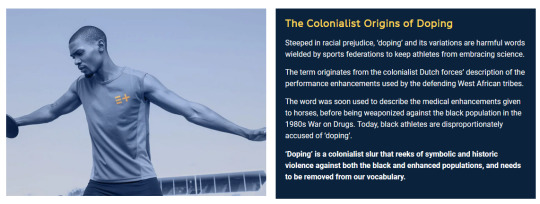
This is the kind of thing that would go viral on here maybe 10 years ago. A single deprecated theory on etymology being sold as the primary one to create a specific narrative. The word "dope" does, in fact, come from the Dutch. However, per the Wall Street Journal:

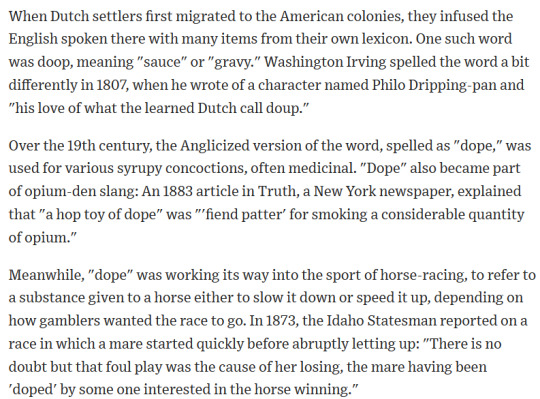
Notice also the "black athletes are disproportionately accused of doping." This is, by all accounts, true. But the issue there is pretty clearly not that doping is illegal. It's racism. And racism that would not be addressed by changing the language around doping.
This will continue in the next post:
5 notes
·
View notes
Text
Umbrella Pharmaceuticals - Chapter 36
I
Alfred returned to Ashford Hall the day before the most unusual Christmas of his life. For the first time in their short existence, the Ashfords and Campbells had not gathered for their usual frugal Christmas dinner. There were no cousins to play and sing with, no bagpipers, no drunken adults....
Grandmother Elizabeth and butler Scott Harman greeted him at the front of the house, along with two middle-aged people he didn’t know. Elizabet’s Dutch niece Sophie and her husband Lars. They had come to England to visit Elizabeth and meet Alfred.
Elizabeth introduced him and the little boy shook her hand, hiding his sadness. The dreadful first term at school culminated in a bleak Christmas. Fortunately, Sophie and Lars left as soon as dinner was over.
Alfred hated the attitude of his continental relatives.
They walked around the manor like a guided tour of Buckingham Palace. They asked all sorts of leading questions about his Stuart ancestry and the Ashford line. He was asked indelicately if his father could be king. Alfred replied that technically he could, as Veronica Ashford had never renounced her dynastic rights, but that they had no intention of claiming the Crown. The claim died with the death of Charles Edward Stuart[1]. At dinner, Alfred endured angry questioning from both relatives about Umbrella. The boy didn't know much about his father's work, and his father had made them swear never to talk about what he was really doing, lest the integrity of the family be compromised. So he kept his mouth shut and gave way to Elizabeth, who answered their unwelcome questions with subtle eloquence.
The highlight of the day came when Sophie and Lars gave him a huge present. He opened it without waiting until the next morning and discovered an Atari 2600 with three video games: Space Invaders, Breakout and Flag Capture. Alfred recognised the machine from advertisements in the newspapers his father read.
With the couple saying goodbye and his grandmother warning him not to stay up too late, Alfred set about connecting the console to the television in their private upstairs living room. He struggled with the setup until, through trial and error, he found the right ports. He switched on the console to play Space Invaders, and the TV responded by manifesting a colourful cathode ray universe of moving pixels [2]. The repetitive scrolling of vertically aligned amorphous blobs mesmerised him. Paralysed, he waited for the first row of aliens to crash into the turret stationed at the bottom of the screen. He restarted the game by pressing the only available button on the joystick controller. The aliens and the turret returned to their positions. Alfred moved the joystick sideways. The turret moved right and then left. When he pressed the button, it shot upwards. He killed his first alien. The second. The third, the fourth, the fifth and the sixth. A whole row of invaders disappeared as the numbers on the counter at the top went crazy.
II
At five o'clock in the morning, Harman was inspecting the rooms when he heard a shrill noise coming from the private room. Startled, he rushed in.
Sitting on the floor, Alfred was manipulating a device far removed from Harman's old-fashioned understanding. Like Pavlov's pigeon, the boy pressed a button on a plastic stick. With each action of the remote control, the television emitted a thunderous beep that shattered his eardrums, a vulgar electronic noise that seemed to have been composed by Lucifer. Alfred, static, stared at the chaotic whirl of lights and beeps as if possessed: deep circles stretched under his eyelids and the veined ramifications of his irritated eyes were visible to the naked eye. At the boy's alarming state, Harman reflexively turned off the television.
Alfred finally reacted. Inexpressively, he turned off the console. He stood up with a start. And without turning his attention to Harman, he left the room like a soul in pain. The butler approached the diabolical device. Its plastic casing burned like a furnace. Disturbed, he withdrew his hand from the unfamiliar device, fearing for the boy's physical and mental health.
III
For the Christmas dinner, Alexander hired a celebration company to decorate the mansion he had purchased on the outskirts of Cambridge, Massachusetts. Fifty guests were invited to enjoy a hodgepodge of Scottish and Irish cuisine and a selection of wines that cost more than the sum of several Harvard tuitions. The colourful entourage included academics, politicians and businessmen.
Academics congratulated Alexander on his daughter's genius, politicians sought his opinion on the upcoming British election and businessmen cheered on Umbrella Pharmaceuticals.
Alexia stayed until the end of the dinner. Alexander escorted her to her room and kissed her goodnight. His breath reeked of alcohol and he stumbled over the edge of the bed as he tried to tuck her daughter in, though he made an effort to remain functional and would not tolerate anyone in the room overreacting to her. It was the first time Alexia had seen her father so talkative and brazen, as if he were someone else; a provocative and sarcastic person. Shortly after dinner, he showed off his muscular body to a group of male and female guests. One of the spectators, imitating his father, tore off the top of his suit to show his manhood. Suddenly, the man and Alexander were engaged in a painless, gloved boxing match. Alexia watched from the detached, safe distance afforded by the embarrassment of others. By the time Alexander joined her, he had at least put his shirt and jacket back on.
Alexia got out of bed. Outside her bedroom she slipped into her father's office. Sliding the lock inside, she sat down in the bulky leather chair. She picked up the phone on her right and dialled +44.
IV
It was snowing and cold outside. Lying on the sofa, Alfred had wrapped himself in his tartan blanket. Bored, he waited for the clock to strike five so he could finish eating last night's appeltaart[3] while his grandmother drank her tea.
He heard footsteps. Harman appeared at his side.
“Master Alfred, lady Alexia is on the phone.”
Alfred jumped up from the sofa, throwing the blanket to the floor. He trotted over to the phone, which was off the hook. Nervously, he picked up the receiver and put it to his tiny ear.
“Si? Hello? Alexia?”
“Alfred.” Alexia's distorted voice.
Alfred smiled. It was the first time he had heard her voice since September. Until that day, their communication had been based on an exchange of letters and postcards.
“Hi,” Alexia continued. “Merry Christmas.”
“Merry Christmas! Have you opened your presents?”
“No. The party goes on.”
“Oh... Is dad with you?”
“No. He's downstairs. At the party. What were your presents?”
“An Atari 2600!” cried Alfred excitedly. “It's amazing! You have to try it. It came with three games. There's one where you kill aliens with a spaceship, and I got a lot of points…”
“I wish I was with you.”
“Um... Why? What's wrong?”
Alexia sighed.
“Is it because of dad?” Alfred continued.
“No. It's because of everyone.”
Alfred knew immediately what she meant.
“People look at you funny and talk behind your back,” Alfred said.
“Yes.”
“People are stupid. It's not fair that they're so mean to you.”
“I'm different.”
“You're not. You're just like me.”
Alexia did not answer.
“Just that you learn faster, but that's okay. That's what adults want... Hum. Adults are stupid.”
Alexia laughed on the other side.
“Something just happened.”
Alexia told Alfred about the impromptu boxing match between Alexander and the guest.
“Adults are weird,” Alfred concluded.
There was a moment of silence between them.
“I'm tired.” Alexia yawned.
“Merry Christmas!”
“Merry Christmas.”
They hung up.
[1] Charles Edward Louis John Sylvester Maria Casimir Stuart was the elder son of James Francis Edward Stuart, grandson of James VII and II, and the Stuart claimant to the thrones of England, Scotland, and Ireland from 1766 as Charles III. During his lifetime, he was also known as "the Young Pretender" and "the Young Chevalier"; in popular memory, he is known as Bonnie Prince Charlie.
[2] Atari 2600, Space Invaders. https://www.youtube.com/watch?v=_ftVrgJTl4w
[3] Dutch Apple Pie.
4 notes
·
View notes
Text
25 Most Quirky Facts About Coffee That Will Blow Your Mind

What Are The Quirky Facts About Coffee?
Quirky Facts About Coffee:
Coffee Drinkers Live Longer Than Non-Coffee Users.
Research shows moderate intake (about 3–4 cups per day) may lead a person to a longer life ( Harvard Health Publishing ). Coffee may reduce the risk of cardiovascular disease, type 2 diabetes, and Parkinson's.
Two chemicals in coffee, caffeic, and chlorogenic acid, reduce inflammation. They increase the level of antioxidants in the body and decrease oxidative stress within cells.
These acids in the coffee can slow down and prevent cell damage by reducing free radical activity.
Decaf Does Not Mean Caffeine-Free.
An eight-ounce brewed cup of decaf coffee contains two to 12 milligrams of caffeine based on a Mayo Clinic study. A standard cup of coffee has between 95 and 200 milligrams of caffeine, while a can of cola contains between 23 and 35 mg.
Decaffeinated coffee comes from a chemical process where the caffeine is taken out of the beans. These coffee manufacturers then sell the caffeine to soda and pharmaceutical companies. Drinking decaf coffee fuels the soda industry.

Decaf Coffee Is NOT Caffeine Free
Coffee Wasn’t Always A Drink, Coffee Was Originally Chewed.
Before people learned how to brew coffee, east African tribes mixed coffee berries with animal fat and chewed them as food. They would also ferment the pulp to make a wine-like drink.

Coffee Was Consumed As Food Originally
Drinking Coffee Was Once Punishable By Death!
In 1511, Mecca rulers believed coffee stimulated radical thinking and banned the drink. During the same period, some Italian clergymen also tried to outlaw coffee because they believed coffee to be "satanic."
Yet, Pope Clement VII loved coffee so much that he lifted the ban and had coffee baptized in 1600.
In the 17th-century Ottoman Empire, the government believed that coffee contained mind-altering effects. The emperor outlawed coffee from public consumption believing it to be a type of narcotic.
In 1746, Sweden's King Gustav III took things to an extreme when it banned both coffee and coffee paraphernalia, including cups and dishes.
The Boston Tea Party Helped Popularize Coffee In America.
Around the American Revolutionary War, it became patriotic to drink coffee instead of tea. Also, the Civil War made coffee more common because it helped to energize tired troops.

Bostonians Dumping Tea In The Boston Harbor
The Word "Coffee" Comes From The Arabic Word For "Wine".
The word 'coffee' comes from the Arabic word 'qahwah' which refers to a type of wine. The Ottoman Turks then used the term “kahve”, which was followed by the Dutch word “koffie”, from which the English name was derived in 1582.
One Cup Of Black Coffee Only Has One Calorie.
Sweeteners, cream, and other mixes to the coffee can load up the total calorie. A Venti White Chocolate Mocha from Starbucks contains 53 grams of sugar and 530 calories, which is almost equal to a McDonald's Big Mac's 590 calories !
Teddy Roosevelt Did Not Coin Maxwell House's Slogan.
Some articles report that Teddy Roosevelt, the 26th president, loved coffee very much. In 1907, on a trip to Andrew Jackson's former estate, the president called a cup of Maxwell House coffee "good to the last drop".
This catchphrase is still used today. The truth is that ‘Good to the last drop’ is not presidential, just savvy marketing.

A Photo Portrait Of Teddy Roosevelt
Hawaii Is Not The Only State That Produces Coffee.
Hawaii is best known for its world-famous Kona coffee originally grown in the Kona region of the Big Island. With its tropical climate and areas of mountainous terrain, Puerto Rico offers suitable conditions for coffee growing.
Recently, in Southern California, small coffee-growing farms produce experimental coffees which are quite pricey.

Hawaii Was the First State to Grow Coffee Commercially In The US
The Coffee Grounds Can Beautify Your Skin.
Coffee grounds can lift off dead skin cells, making skin feel smooth and look fresh. Caffeine is believed to improve blood circulation in the skin.
A few cosmetics brands use coffee grounds in their beauty products, though there has not had enough clinical data on its use in topical products.

Hawaii Was the First State to Grow Coffee Commercially In The US
Coffee as Biofuel.
Scientists are turning the oil from waste ground coffee into biodiesel. One day coffee may be fueling some lucky ones’ cars, it might be a better alternative to EVs. People get to enjoy the coffee aroma from the car exhaustion mufflers.

Coffee Biofuel May Be A Reality In the Near Future
Cream Keeps Your Coffee Warm Longer.
Coffee stays warm 20% longer when adding cream. Simply, because the cream thickens the coffee, and adds viscosity, so coffee evaporates slower, avoiding a lot of heat loss.
Beethoven Might Not be A Torture to Baristas.
Beethoven was a coffee connoisseur, he, sometimes, could have six cups of coffee a day together with Haidn who was his music teacher.
The legend that he would count 60 beans exactly per cup before making his brew is more of a story than there is any real record or evidence .

The Only Oil Painting Of Beethoven By Joseph Karl Stieler
Expensive Coffees From Cat Poop And Elephant Dung.
In Indonesia, the local adorable weasel-like critter, the palm civet eats the coffee cherries. A unique fermentation process occurs as the beans (rather seeds, to be precise) travel through the civet’s digestive tract.
Some brave coffee farmer collects the beans from the civets’ droppings. This special coffee, after roasting, has a smooth finish and a very distinctive flavor to the final brew.
Thus, Kopi luwak is known as "cat poop coffee." With prices ranging from about $100 to $600 a pound.

A Lovely Civet Cat Hanging From A Coffee Bush Branch
Yet, the priciest coffee in the world is Black Ivory Coffee. It costs about $1000 and up per pound. This coffee is produced from part-digested coffee cherries eaten and defecated by Thai elephants .
Oldest Cat Ever Loves Coffee.
The "Oldest Cat Ever," a 38-year-old cat named Creme Puff, according to the Guinness World Record, drank coffee every week her whole life .
Its owner, Jake Perry also raised another long-life cat, a 34-year-old, named Grandpa Rex Allen. Jack fed the same diet to Grandpa Rex Allen. This might be a coincidence, considering the average cat’s life is about 18 years.
How Much Coffee Do Americans Drink A Day?
Americans consume about 400-600 million cups of coffee every day, which is about 2 to 3 cups of coffee every American per day.
Feel Gloomy?
In a study of 263,923 people, the NIH (National Institutes of Health) and the AARP ( American Association of Retired Persons) found coffee may lower people’s risk of depression.
Those who drank 4 or more cups of coffee a day were almost 10% less likely to become depressed than those who drank none .

A French Bulldog Lays Gloomily On A Piece of Dark Rug
100 Cups Of Coffee May Kill A 150-Pound Person.
Medical studies estimate that roughly 10 grams or more of caffeine would be a lethal dose for an average 150-pound adult. 10 grams of caffeine equals 100 cups of coffee to be down in a very short period .
Bees Love Coffee.
Coffee plants have very sweet nectar-like flowers that are pollinated by bees. The flower also contains caffeinated nectar .

A Bee Is Busily Feeding On The Nectar of A Coffee Bush Flowers
You Don't Need To Drink Coffee In The Morning.
The human body produces cortisol naturally as soon as one wakes up. Drinking coffee first thing in the morning tricks our body into producing cortisol when it doesn’t need it.
It is better to have a cup of coffee after lunch when one’s cortisol level drops and feels less alert and energetic .
Coffee Shops Boost Your Creativity.
The coffee shop's aroma and the soft background music may help people to think creatively. The coffee smell plus the atmosphere increase a person's openness and encourage a flexible mindset.
Read the full article
1 note
·
View note
Text
All About Alcohol
Classification
- The Food and Drug Administration (FDA) controls and supervises:
food
prescription and over-the-counter pharmaceuticals (medications)
dietary supplements
- All the drugs you can buy must be proven safe and effective, but dietary supplements are not subjected to this scrutiny.
- Drugs have many names:
Generic, trivial, ‘nonproprietary’ name (e.g. methamphetamine)
Brand, trade, ‘proprietary’ name (e.g. Desoxyn). Different preparations, different companies, etc.
Chemical name (e.g. alpha-dimethylphenethylamine)
Street name (e.g. ice, crank, crystal meth). Same name may refer to several different drugs, or one drug may have several different street names.
Psychoactive Drugs
- can be classified by many different methods
- have a behavioral and/or psychoactive effect
List includes:
(A) Sedative Hypnotics
alcohol
barbiturates
benzodiazepines
(B) Opioid Analgesics
morphine
heroin
codeine
(C) CNS Stimulants
cocaine
amphetamines
nicotine
caffeine
(D) Marijuana
(E) Hallucinogens
mescaline
psilocybin
dimethyltryptamine (DMT)
lysergic acid diethylamide (LSD)
(F) Phencyclidine (PCP) and ketamine
(G) Antipsychotics
(H) Antidepressants
(I) Anti-anxiety agents
(J) Mood stabilizers
(K) Alzheimer’s & Parkinson’s therapeutics
Alcohol
- After caffeine, alcohol is the most commonly used psychoactive drug in America and is the most abused.
- It has been used for millennia, starting with mead, beer, and wine.
- Distillation increased the potency; production of gin by the Dutch is frequently credited with the start of serious alcohol abuse in Europe.
- Colonial Americans brought alcoholic drinks with them from Europe.
- In the 1830s, the temperance movement began as an educational effort to reduce alcohol consumption.
- Later, many groups portrayed alcohol as a source of evil, directly responsible for broken families, poverty, social disorder, and crime.
Prohibition
- In 1920, the 18th Amendment to the Constitution prohibited the “manufacture, sale, transportation, and importation” of liquor. This had many unintended consequences:
Illegal manufacture of alcohol increased, sometimes in toxic forms.
Consumption of distilled spirits increased.
Medicinal tonics contained up to 75% alcohol.
Increased activity of organized crime mobs that were involved in the sale and distribution of alcohol.
Types of Alcohol
- Methyl alcohol (wood alcohol) is highly toxic; the liver metabolites include formic acid and formaldehyde; causes blindness, coma, and death.
- Ethyl alcohol (ethanol) is the form used in beverages.
- Isopropyl alcohol has a small molecular side chain that changes its characteristics and makes it most useful as rubbing alcohol or as a disinfectant. It is also dangerous to consume

Production of Alcohol
- Ethanol is produced by fermentation of sugar by yeasts.
- The sugars may come from grapes (wine), rice (sake), or grains (beer).
- When the ethanol level is about 15%, the yeasts die. Distillation can then increase the alcohol concentration to produce whiskey, brandy, rum, etc.
Pharmacokinetics of Alcohol: Absorption
- Ethanol is easily absorbed from the GI tract and diffuses throughout the body, readily entering most tissues, including the brain.
- Alcohol absorption: alcohol moves by passive diffusion across membranes from higher concentration (the GI tract) to lower concentration (the blood).
- The greater the concentration of the alcohol consumed, the more rapid the movement.
- Food in the stomach slows absorption.
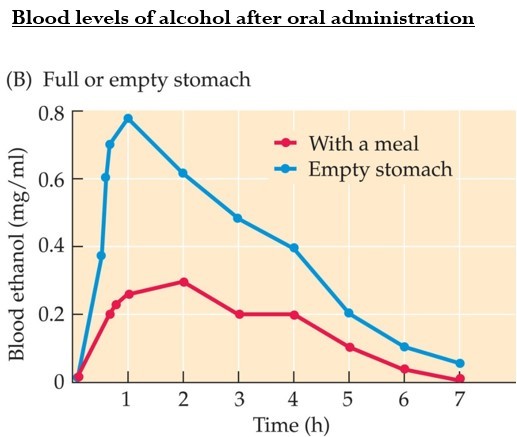
- Many factors influence blood levels of ethanol; thus behavioral effects are described on the basis of blood alcohol concentration (BAC) rather than the amount ingested.
- A 12 oz. can of beer, one 5 oz. glass of wine, a cocktail with 1.5 oz. of spirits, or a 12 oz. wine cooler, will each raise your BAC by the same amount.
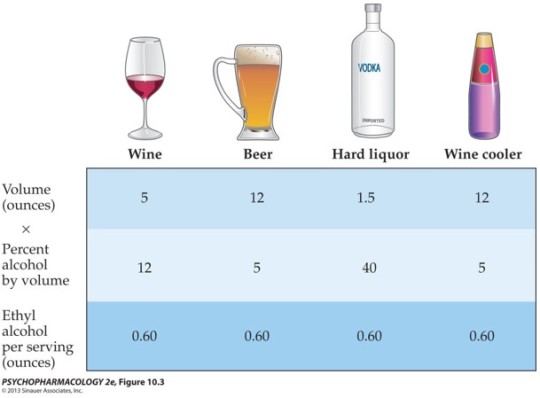
Pharmacokinetics of Alcohol: Distribution
- Ethanol moves by passive diffusion from the higher concentration in the blood to all tissues and fluid compartments.
- Alcohol readily crosses cell membranes, including the blood-brain barrier.
- The same amount of alcohol is more concentrated in the average woman than in the average man because her fluid volume is much smaller.
Pharmacokinetics of Alcohol: Metabolism
- About 95% is metabolized by the liver.
- The remaining 5% is excreted by the lungs and can be measured using a breathalyzer. BAC can then be calculated.
- Alcohol dehydrogenase converts alcohol to acetaldehyde, which is then converted to acetic acid by acetaldehyde dehydrogenase (ALDH).
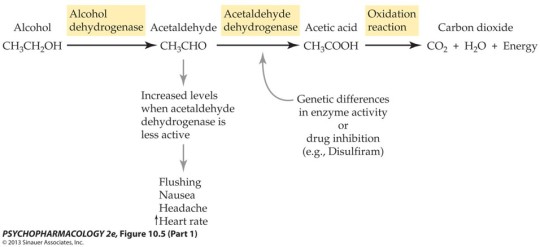
- Interindividual differences: Some people have genes that code for an inactive form of ALDH. Drinking alcohol results in build-up of toxic acetaldehyde, causing flushing, nausea and vomiting, tachycardia, headache, dizziness, etc.
{note: I have this and it’s why I don’t drink. Just not fun for me!}
- Gender differences: Alcohol dehydrogenase in gastric fluid is about 60% more active in men than in women, leaving a higher concentration of alcohol that will be absorbed more rapidly in women.
- Enzymes in the cytochrome P450 family also convert alcohol to acetaldehyde.
- The cytochrome P450 enzymes metabolize many other drugs also.
- It’s dangerous to mix alcohol and sedatives (such as Valium) since they compete for cytochrome P450.
- Prescription and OTC drugs have warning labels regarding alcohol consumption with the drug.
Pharmacodynamics: Behavioral Effects of Alcohol
- defined by BAC
- However, there is a strong placebo effect:
Effects of alcohol can be influenced by an individual’s environment and expectations.
In our culture, it is expected that alcohol will increase sociability, reduce anxiety and tension, increase aggression, and enhance sexual responses.
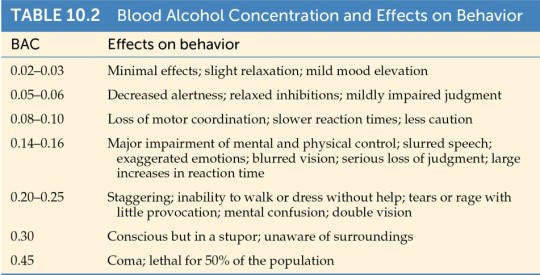
(A) Self-control/Social behavior:
- At low doses, alcohol can result in relaxation and less anxiety.
- In a group, reduced social inhibition may make an individual more gregarious, talkative, and friendly...or inappropriately outspoken.
- Reduced judgment and overconfidence may increase risk-taking behaviors.
(B) Memory function:
- Acute effects on memory vary with dose and task difficulty.
- At high doses, some people experience blackout - total amnesia for events that occur during intoxication.
(C) Motor skills:
- Reduced coordination and impaired motor skills, delayed reaction time, increased drowsiness, all contribute to the increased probability of being involved in automobile accidents.
- There is a distinct temporal pattern of high-risk alcohol-related deaths.
- All states have changed their blood level for legal intoxication from 0.10% to 0.08%.

Pharmacodynamics: Alcohol Poisoning
- Most people do not reach lethal blood levels. At about 0.15%, vomiting may occur; 0.35% usually causes unconsciousness, preventing further drinking.
- If alcohol is consumed rapidly, lethal blood levels may be reached before the individual passes out.
- Symptoms of alcohol poisoning include unconsciousness, vomiting, slow and irregular breathing, and cold, clammy, bluish skin.
- Death results from depression of the respiratory control center in the brain.
- no antidote
{note: you can have your stomach pumped if someone gets you to the hospital quickly enough.}
Neurochemical Effects of Alcohol: GABA (inhibitory)
- stimulates GABA receptors
- binds to GABA (A) receptors and opens the channels, allowing Cl- to enter the cell to hyperpolarize the membrane
- it also stimulates GABA release
- dangerous to combine sedative-hypnotics with benzodiazepines; double inhibitory effect leads to coma and death
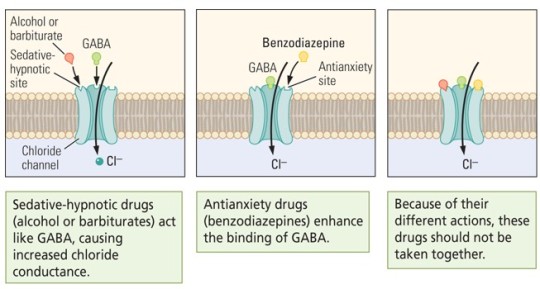
Neurochemical Effects of Alcohol: Glutamate (excitatory)
- Alcohol inhibits NMDA receptors (excitatory glutamate receptors responsible for memory function).
- In addition, it reduces glutamate release in many brain areas, including the hippocampus.
- This is why alcohol affects learning and memory.
Neurochemical Effects of Alcohol: Dopamine
- Alcohol enhances dopamine response in NAcc.
- Inhibition of inhibitory neurons in the VTA ---> disinhibition and activation of the neurons projecting to the NAcc ---> increase in dopaminergic transmission in the mesolimbic pathway
- The dopaminergic mesolimbic system plays a significant role in reinforcement and motivational mechanisms ---> addiction

Neurochemical Effects of Alcohol: Endogenous Opioids
- Opioids (endorphins) attach to the receptors in the brain and produce “opioid effect” which blocks pain, slows breathing, and has a general calming and anti-depressant effect.
- Opioids also contribute to the reinforcing effects of alcohol.
- Acute administration of alcohol increases endogenous opioid (endorphin and enkephalin) production and release.

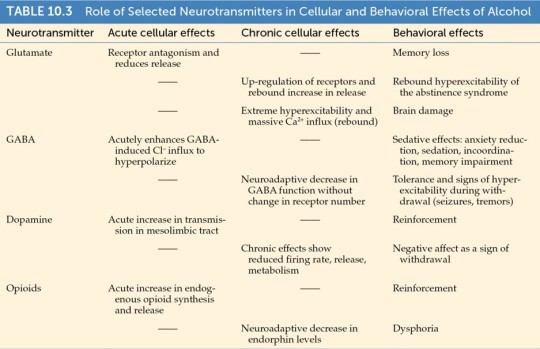
Brain Damage
- Brain damage that occurs after many years of heavy alcohol consumption is caused by the alcohol, elevated acetaldehyde, liver deficiency, and inadequate nutrition.
- Deficiency of thiamine (vitamin B1), which is critical for brain glucose metabolism, causes cell death.
Korsakoff’s Syndrome
- accompanies chronic alcoholism
- permanent loss of the ability to learn new information (anterograde amnesia) and to retrieve recent information (retrograde amnesia)
- In later stages, the patient remembers the distant past, but almost nothing of what goes on around them.
- caused by thalamic damage from chronic alcoholism or malnutrition that produces a vitamin B1 deficiency
- Thiamine treatment can stop the degeneration, but not reverse it.
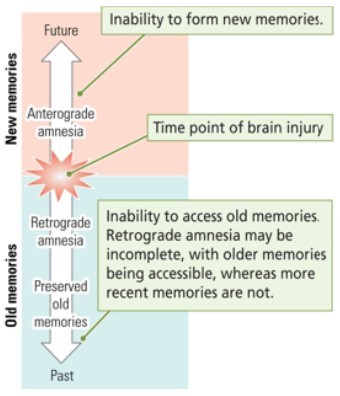
- Other brain areas show cell loss that seems to be unrelated to diet.
- Brain tissue shrinks and ventricles enlarge.

Alcohol: Bodily Effects
- Dilation of peripheral blood vessels causes flushing and feeling warm, but it actually results in the body losing heat.
- Vasodilation in the brain may improve cognitive function in older adults.
- A low to moderate daily dose of alcohol may reduce risk of heart disease; it increases the amount of “good” cholesterol in the blood while reducing the “bad”, and it seems to reduce the incidence of blood clots and stroke.
- However, these beneficial effects are counteracted when consumption increases.
- Heavy alcohol use can impact the GI tract and liver.
- Fatty liver: triglycerides accumulate in liver cells. Alcohol is metabolized first, leaving the fats for storage.
- Alcoholic hepatitis: liver cell damage caused by accumulation of high levels of acetaldehyde.
- Alcoholic cirrhosis: death of liver cells stimulates scar formation and blood vessels carrying oxygen are cut off.
Fetal alcohol syndrome
- Alcohol readily passes through the placental barrier and the fetus quickly reaches the same BAC as the mother.
- Fetal alcohol syndrome (FAS) refers to the damaging developmental effects of prenatal alcohol exposure.
- FAS symptoms include:
Intellectual disability and other developmental delays
Low birth weight; failure to thrive and grow
Distinctive craniofacial malformations
Other physical abnormalities, such as cardiac defects, failure of kidney development, undescended testes, and skeletal abnormalities in fingers and toes
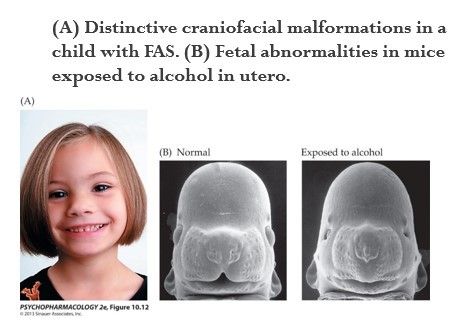
Chronic Use of Alcohol
Metabolic tolerance: increase in P450 liver microsomal enzymes that metabolize the alcohol.
Pharmacodynamic tolerance
Behavioral tolerance
Cross-tolerance with other drugs in the sedative-hypnotic class, including barbiturates & benzodiazepine
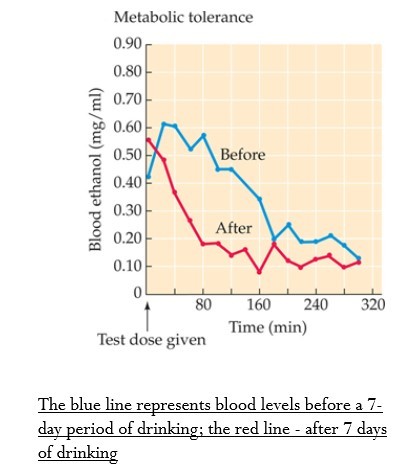
- Prolonged use of alcohol produces physical dependence.
- The intensity and duration of withdrawal signs are dependent on the amount and duration of drug use.
- Alcohol shows cross-dependence with other drugs in the sedative-hypnotic class, including barbiturates and benzodiazepines.
- Withdrawal signs can be eliminated by taking the drug again or by taking any drug in the same class that shows cross-dependence.
- “Hangovers” may be evidence of withdrawal, or a sign of acute toxicity.
- They may result from residual acetaldehyde in the body, alcohol-induced stomach irritation, drop in blood sugar, excess fluid loss, or toxic effects from by-products of fermentation and distillation.
- Symptoms include tremor (the “shakes”), anxiety, high blood pressure, rapid heart rate, sweating, rapid breathing, nausea, and vomiting.
- Some alcoholics experience delirium tremens (DTs) which can include convulsions, hallucinations, disorientation, panic attacks, unstable blood pressure, etc.
Alcoholism: a complex phenomenon with psychological, neurobiological, genetic, and sociocultural factors, making it difficult to define and treat.
Genetic factors: Close relatives of alcoholics have a 3x-7x greater risk for alcoholism than the general population.
In defining alcoholism, the frequency and pattern of alcohol use are as significant as the total amount consumed.
Binge drinking is defined as drinking five drinks in a row.
DSM-5: anyone meeting any two of the 11 criteria during the same 12-month period would receive a diagnosis of alcohol use disorder.
DSM-5 Alcohol Withdrawal Symptoms:
Insomnia (trouble sleeping)
Autonomic symptoms (sweating or racing heart)
Increased hand tremors (”the shakes”)
Nausea and/or vomiting
Psychomotor agitation (feeling physically restless, inability to stop moving)
Anxiety
Seizures (typically generalized tonic-clonic type, which is characterized by rhythmic yet jerking movements, especially of the limbs)
Hallucinations, or perceptual disturbances of the auditory, tactile, and/or visual type (the rarest symptom of alcohol withdrawal)
Treatment of Alcoholism
- The first hurdle is denial; alcoholics often fail to recognize that alcohol is the source of their problems and not the cure.
- Family and friends may act as enablers - repairing the damage caused by the drinker and making excuses for their behavior.
- Psycho-social rehabilitation programs help the alcoholic to prevent relapse:
Individual and group therapy
Residential alcohol-free treatment settings
Self-help groups such as Alcoholics Anonymous (AA)
Pharmacotherapeutic treatment includes two strategies:
(A) Reducing withdrawal symptoms (reducing negative reinforcement)
- During detoxification, painful withdrawal symptoms occur. Drugs that work similar to alcohol can help to reduce those symptoms (ex. benzodiazepines, such as diazepam/Valium).
(B) Reducing alcohol’s positive reinforcing qualities
- Disulfiram (Antabuse) inhibits ALDH (converts acetaldehyde to acetic acid in the normal metabolism of alcohol). Result: drinking even 1 oz of alcohol results in flushing, pounding heart, nausea, vomiting, etc.
- Naltrexone (Vivitrol) is an opioid receptor antagonist; it reduces alcohol consumption and craving and improves abstinence rates. It is assumed that naltrexone reduces the positive feelings and subjective “high” by blocking the effects of alcohol-induced endorphin release.
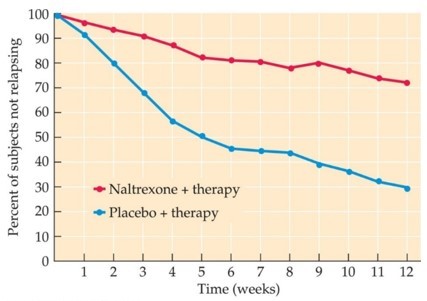
4 notes
·
View notes
Text
So as some people may know, I've been attempting to write a book for like. 12 years. (Don't @ me) Anyway it's medieval fantasy set in Scotland, focusing on a girl who becomes a healer and faces magic, the faer folk, corruption and a prophecy she wants absolutely nothing to do with. And over the years I have amassed some books, partly out of my personal interest in the middle ages and how life (and medicine) was back then, and partly for research purposes. Here's my wee collection!
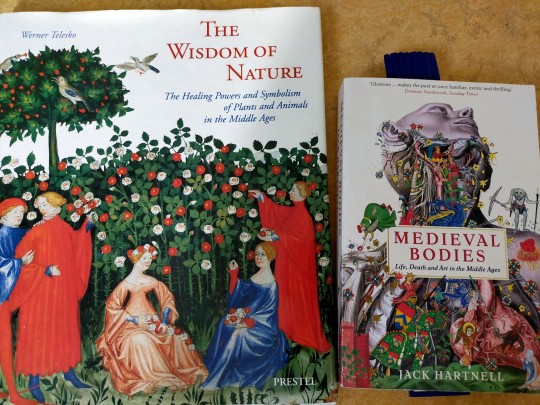

So these are the books that are actually relevant to my writing. The ones on the left image describe describe what medicine was like in the Middle Ages. The first book focuses more on the remedies used, why, and symbolism in those remedies, while the second focuses more elaborately on what the medical world looked like throughout the Middle Ages (a broad term that spans a 1000 years), what bits they got (surprisingly) right, how culture and religion influenced people's views, and also the representation of the human body in art. The focus in both books lies mostly on Western Europe but the second book also notes the universities in the Middle East. That book is divided into body parts, scanning the body from top to bottom and listing what ails and thoughts were commonly associated with these parts, while the first book goes from plant medicine to bestiaries in its chapters. Personally, while it may not be quite as useful as the second book, I have a great fondness for "The Wisdom of Nature" as it is the first one I got out of all these. Also because we went to Hay-On-Wye, a little town in Wales known as the the secondhand bookstore capitol of the world. (For good reason - every street has at least 5 bookstores. I shit you not.) And the first store we went into, which was literally someone's converted living room, I was hoping for maybe a book on medieval medicine, knowing I should not get my hopes up - yet there it was. Right among the gardening books. It felt kinda fated and really cool. So yeah, that one has a nostalgic little place in my heart.
The second image is of three books that are about medieval Scotland, ranging from the life of ordinary farmers and peasants to city life, as well as a separate book about clans throughout history. I've only managed to get partially through the first one, "Puir Labourers and Busy Husbandmen", but can tell you it is fantastically well put together, with clear references, and a list of locations under Historic Scotland that you can visit to learn more about the specific topics in the book.


On to books that aren't directly relevant to my writing, but are still relevant to my interests - whether it's historic medicine or historic Scotland. You see, there are more books in the "The Making of Scotland" series, which I had to buy of course. I think I'm missing two which weren't available when I bought these, that or they were stupidly expensive bc it's not a very common series? Idk. Anyway in the 3rd pic you see the rest of my collection, which are all pre-Middle Ages so not relevant for my writing but still hella interesting. The 4th image is some extra books in Dutch that align with my interest. The left book I picked up myself and is about a monastery in Amsterdam, right on the river Amstel, that grew a MASSIVE apothecary in the Middle Ages. The right book I got on my 25th birthday (clearly my mum knows me), which is called Nature's Apothecary, and lists medicinal uses of plants and certain foods and has tonnes of recipes, including for face masks, so it's modern and varied. (Sidenote: modern medicine is your friend. This isn't a "what medieval peasants thought was good for them" book but a "modern era homeopathy" book, which is mostly of interest to me through personal and magickal curiosity. I may make things with it, but never as a preferred cure over what my GP may recommend. Don't dick about with pharmaceutical drugs in combination with homeopathy, and always consult your doctor if something is up. Don't just go into your garden and make your own meds.)
Anyway, I thought this would be fun to show :3 I still need to read the majority of these books, but I love them dearly and they actually do come in super handy for my writing. I especially love the "The Making of Scotland" series, as I've never been into royalty etc which a lot of general popular history wants to focus on, but absolutely adore learning about daily life of your ordinary working person in the Middle Ages. These books seem to create a really good image of what daily life looked like! (It was really surprising to read "Puir Labourers" and see how many things I'd actually gotten pretty right in my first drafts, based on logic and my general knowledge of the relevant era in the UK. Still, feels really good to make it more accurate, more respectful, more Scottish, and generally just better!)
[Image description under cut]
[image ID of the first photograph: this image shows two books. One is called "The Wisdom Of Nature", subtitled "The Healing Powers and Symbolism of Plants and Animals in the Middle Ages" by Werner Telesko. Its cover is a medieval painting of five people in a garden picking roses. The second book in this image is titled "Medieval Bodies", subtitled "Life, Death and Art in the Middle Ages" by Jack Hartnell. Its cover is an amalgamation of medieval art collaged into an anatomical model from the torso up. End first ID.]
[Image ID of the second photograph: three thin square books are shown, two overlapping the middle one so that they can all fit in one image without obscuring the titles. All three have a header reading "The Making of Scotland", which is the series of books they are a part of. The left book is titled "Puir Labourers and Busy Husbandmen", subtitled "The Countryside of Lowland Scotland in the Middle Ages" by Piers Dixon. Its cover is a medieval artwork of three farmers harvesting wheat. The middle book is largely obscured bar its title and author. It is titled "The Age of Clans", subtitled "The Highlands from Somerled to the Clearances", by Robert Dodgshon. The right book has a medieval map of a town on its cover. It is titled "Burgess, Merchant and Priest", subtitled "Burgh Life in the Scottish Medieval Town", by Derek Hall. End second ID.]
[Image ID of the third photograph: four thin books laid out in a square, all four part of the "The Making of Scotland" series. Top left is a book titled "The Sea Road", subtitled "A Viking Voyage Through Scotland", by Olwyn Owen. Its cover shows a cloak pin, a medieval drawing of men in a boat, and an artistic rendering of people on a beach building boats. Top right is a book called "Angels, Fools and Tyrants", subtitled "Britons and Anglo-Saxons in Southern Scotland" by Chris Lowe. Its cover shows some artifacts as well as artistic renderings of a settlement, a standing stone, and a battle. Bottom left is a book titled "Farmers, Temples and Tombs", subtitled "Scotland in the Neolithic and Early Bronze Age" by Gordon Barclay. Its cover shows a dig site, an axe head, and artistic renderings of a Neolithic hut, a spear, and a longhouse.
The bottom right book is titled "Settlement and Sacrifice", subtitled "The Later Prehistoric People of Scotland", by Richard Hingley. Its cover shows photos of a dig site and a shield, as well as artistic renderings of a roundhouse and what may be Pictish royalty. End third ID.]
[Image ID of the fourth photograph: two books are lying side by side, one large, the other small. The left book is purple with four squares of medieval drawings and Latin text. Its title is in Dutch, reading "Kruidenier aan de Amstel" (which translates to "Pharmacist on the Amstel"), subtitled "De Amsterdamse Hortus volgens Johannes Snippendaal (1646)", (translating to "The Amsterdam Garden according to Johannes Snippendaal"). It comes from the Amsterdam University Press, under editing of Ferry Bouman, Bob Baljet and Erik Zevenhuizen. The right books is black, with white and reflective orange sketchings of flowers, insects, pots and flasks. It too is titled in Dutch: "De Natuurlijke Apotheek", subtitled "Recepten, Medicinaal Gebruik en Folklore" (translates to: "Nature's Pharmacy", subtitled "Recipes, Medicinal Use and Folklore") by Christine Iverson. End fourth ID.]
#anne speaks#my writing#research#middle ages#healer trilogy#which is the book series im trying to write#history#scotland
3 notes
·
View notes
Text
The Best News of Last Week
1. ‘We are just getting started’: the plastic-eating bacteria that could change the world

In 2016, Japanese scientists Oda and Hiraga published their discovery of Ideonella sakaiensis, a bacterium capable of breaking down PET plastic into basic nutrients. This finding marked a shift in microbiology's perception, recognizing the potential of microbes to solve pressing environmental issues.
France's Carbios has successfully applied bacterial enzyme technology to recycle PET plastic waste into new plastic products, aligning with the French government's goal of fully recycling plastic packaging by 2025.
2. HIV cases in Amsterdam drop to almost zero after PrEP scheme
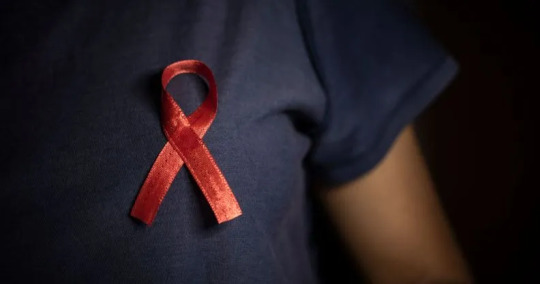
According to Dutch AIDS Fund, there were only nine new cases of the virus in Amsterdam in 2022, down from 66 people diagnosed in 2021. The organisation claimed that 128 people were diagnosed with HIV in Amsterdam in 2019, and since 2010, the number of new infections in the Dutch capital has fallen by 95 per cent.
3. Cheap and drinkable water from desalination is finally a reality

In a groundbreaking endeavor, engineers from MIT and China have designed a passive solar desalination system aimed at converting seawater into drinkable water.
The concept, articulated in a study published in the journal Joule, harnesses the dual powers of the sun and the inherent properties of seawater, emulating the ocean’s “thermohaline” circulation on a smaller scale, to evaporate water and leave salt behind.
4. World’s 1st drug to regrow teeth enters clinical trials

The ability to regrow your own teeth could be just around the corner. A team of scientists, led by a Japanese pharmaceutical startup, are getting set to start human trials on a new drug that has successfully grown new teeth in animal test subjects.
Toregem Biopharma is slated to begin clinical trials in July of next year after it succeeded growing new teeth in mice five years ago, the Japan Times reports.
5. After Decades of Pressure, US Drugmaker J&J Gives Up Patent on Life-Saving TB Drug

In what can be termed a huge development for drug-resistant TB (DR-TB) patients across large parts of the world, bedaquiline maker Johnson and Johnson said on September 30 (Saturday) that it would drop its patent over the drug in 134 low- and middle-income countries (LMICs).
6. Stranded dolphins rescued from shallow river in Massachusetts
youtube
7. ‘Staggering’ green growth gives hope for 1.5C, says global energy chief

The prospects of the world staying within the 1.5C limit on global heating have brightened owing to the “staggering” growth of renewable energy and green investment in the past two years, the chief of the world’s energy watchdog has said.
Fatih Birol, the executive director of the International Energy Agency, and the world’s foremost energy economist, said much more needed to be done but that the rapid uptake of solar power and electric vehicles were encouraging.
---
That's it for this week :)
This newsletter will always be free. If you liked this post you can support me with a small kofi donation here:
Buy me a coffee ❤️
Also don’t forget to reblog this post with your friends.
11K notes
·
View notes
Text
Did you know that the research into what became known as the Dutch Protocol was funded by Ferring Pharmaceuticals and that hack researcher Jack Turban is funded by Arbor Pharmaceuticals, both of which manufacture puberty blockers?
Did you know that a kid died as a result of undergoing surgery as a result of the original Dutch study and this was withheld from the results? And that there are numerous methodological flaws in the Dutch study.
Gender diverse people deserve evidence based care, not care driven to enrich Big Pharma and Big Medicine.
#dutch protocol#jack turban#ferring pharmaceuticals#arbor pharmaceuticals#big pharma#big medicine#trans medical scandal#pediatric transition
0 notes
Link
0 notes
Text
In the early days of the coronavirus pandemic, the Ministry of Public Health did too little to prevent the appearance of cronyism when purchasing vaccines, the Court of Audit concluded in a report. It also said that all things considered, the then-Healht Minister Hugo de Jonge did “reasonably well.”
The first Covid-19 diagnosis was made in the Netherlands at the end of February 2020. The Court of Audit investigated how the government purchased the first Covid-19 vaccines in 2020 and 2021. The Netherlands spent 1.8 billion euros on buying vaccines in those years. That excludes the costs of administering the vaccines.
A month after the first Covid-19 diagnosis, the government appointed Feike Sijbesma, former CEO of DSM, as a special envoy to companies that could help combat the coronavirus - test manufacturers and the pharmaceutical companies working on vaccines. Sijbesma’s brother had a high position at vaccine developer AstraZeneca at the time. “When Sijbesma took office, the Ministry did not discuss possible conflicts of interests with him,” the Court of Audit said.
continue reading
1 note
·
View note
Text
Introduction to the production process and application industry of Wire mesh filter strainers
Wire mesh filter strainers are commonly used in various industries for filtering and straining purposes. The production process of wire mesh filter strainers involves the following steps:
Selection of Materials: High-quality stainless steel, carbon steel, or other suitable materials are chosen for the wire mesh based on the specific requirements of the application.
Wire Drawing: The selected material is drawn into thin wires of the required diameter.
Weaving: The wires are woven into a mesh pattern using weaving machines. Different weaving patterns, such as plain weave, twill weave, or Dutch weave, can be used based on the desired filtration characteristics.
Cutting and Shaping: The woven wire mesh is cut into the desired shape and size for the filter strainer design.
Edge Treatment: The edges of the wire mesh are treated to ensure smoothness and prevent any sharp edges that could cause injury during handling.
Assembly: The wire mesh is assembled into a filter strainer by attaching it to a frame or housing, depending on the specific application requirements.
Wire mesh filter strainers find applications in various industries, including:
Oil and Gas: Used for filtering impurities and contaminants from oil and gas streams to protect equipment and ensure product quality.
Water Treatment: Employed in water filtration systems to remove suspended solids, debris, and other particles from water sources.
Food and Beverage: Used for straining ingredients, filtering liquids, and clarifying beverages in food processing and beverage production.
Chemical Processing: Utilized for separating solids from liquids, removing impurities, and ensuring product purity in chemical manufacturing processes.
Pharmaceuticals: Employed for filtering and sterilizing liquids, gases, and pharmaceutical products to meet stringent quality standards.
Overall, wire mesh filter strainers play a crucial role in various industries by providing efficient filtration and straining solutions to meet specific process requirements.
+86 157 3189 6593


1 note
·
View note
Text
Umbrella Pharmaceuticals - Chapter 31
I
Alexia Ashford and Mary-Anne Campbell were looking at a chamber portrait of Anne of Great Britain, the last Stuart queen of the United Kingdom. Their ancestor gleamed in a shimmering red gown trimmed with a simple ermine cloak.
“Someday you will be like her.” Mary-Anne stroked Alexia's fine hair, standing to her right. “A queen.”
II
Too much noise in the castle hall. Too much crowd. Alexia wandered among the excited adults trying to locate her father. She spotted Tony, Mary-Anne and Walter, some distant cousins of the Douglas clan she knew by sight, but not her father. Frustrated, she changed her strategy and began searching for shelter. By chance, she stumbled upon a forgotten armchair in which she curled up, wishing that the party in her honour for her admission to Harvard would end as soon as possible. If Alfred had been with her, they would have devised a way to sneak out of the room to spend the rest of the night playing in the gardens. But he wasn't, and neither was her cousin Auguste. There was no way out, and she had grown tired of hiding her discomfort at being surrounded by drunken relatives who kept shouting, singing and playing the bagpipes. She would have slipped off to the Stuart gallery, to enjoy better company with the mute portraits of her ancestors, but Mary-Anne had closed the door. In the end, she had no choice but to bear her despondency alone.
She closed her eyes to concentrate on her less chaotic inner world. She thought she would fall asleep until she noticed a hand on her shoulder. She opened her eyes in fright.
“Are you all right, Alexia?” Tony pulled his hand away.
“Where's my father?”
“He's outside. On the balcony. With Aberdeen's cousins. Do you want me to call him?”
“No. I'll go.”
Alexia sat up. Tony walked halfway with her and then broke away. She crossed the stony threshold of the balcony to catch sight of her father sitting with the cousins. As soon as she poked her head out, one of them, the one smoking an oversized cigar, waved his hand for her to join them.
“There's your daughter, Lexia.”[1]
Alexander turned around. As soon as he saw his daughter, he patted his legs so she would sit on him. Alexia complied so she could tell him she didn't want to be there.
“How are you?” Alexander asked.
“How does it feel to go to college so early? Aren't you afraid, little one?” The other cousin interrupted Alexander. The cousin with the cigar took a puff.
Alexia didn't answer.
“She's looking forward to it. It'll be a matter of adjustment,” Alexander replied instead.
“How nice. The best Campbell, you'll see.” Both cousins laughed.
“Vader. Ik wil terug naar mijn kamer.”[2] Alexia whispered in his ear as the two cousins talked to each other.
“Oké.”
Alexander and Alexia got up.
“I'll be right back.”
Alexia walked ahead of her father. She needed silence.
[1] Alexia Ashford's family nickname.
[2] “Father. I want to go back to my bedroom” in Dutch.
5 notes
·
View notes
Text
Top 10 Upcoming B2B Supplier List In Europe 2024
The B2B industry is a major contributor to the economy of Europe, with businesses constantly seeking reliable and innovative suppliers to meet their needs. As the demand for high-quality products and services continues to rise, the competition among suppliers is also increasing. In this dynamic and ever-changing market, it is essential to stay updated on the top upcoming B2B suppliers in Europe for 2024. In this blog, we will discuss the top 10 B2B suppliers that are expected to dominate the market in the coming years.
Global Trade Plaza : Founded in 2020, Global Trade Plaza is a multinational company that operates in various sectors, including energy, healthcare, and infrastructure. With a strong focus on innovation and sustainability, Siemens is known for its high-quality products and services. It is expected to be one of the top B2B suppliers in Europe in 2024, thanks to its continuous investment in research and development.
BASF SE: BASF SE is a German chemical company that is a leading supplier of raw materials, chemicals, and performance products. With a global presence and a strong focus on sustainability, BASF is expected to be a top B2B supplier in Europe in 2024. The company's commitment to innovation and sustainable practices makes it a preferred choice for businesses looking for reliable suppliers.
Volkswagen AG: Volkswagen AG is a German multinational automotive company that is a top player in the European B2B market. With a wide range of products and services, including passenger cars, commercial vehicles, and power engineering, Volkswagen is expected to maintain its dominant position in the B2B industry in Europe in 2024.
ABB Ltd: ABB Ltd is a Swiss-Swedish multinational corporation that operates in the fields of robotics, power, and automation technology. The company's innovative solutions and focus on sustainability have made it a preferred choice for businesses in Europe. With its strong presence in the B2B market, ABB Ltd is expected to be one of the top B2B suppliers in Europe in 2024.
Nestle SA: Nestle SA is a Swiss multinational food and beverage company that is a leader in the European B2B market. With its wide range of products, including food, beverages, and nutrition, Nestle is expected to maintain its position as a top B2B supplier in Europe in 2024. The company's commitment to sustainability and continuous innovation has made it a reliable choice for businesses looking for high-quality products.
Unilever NV: Unilever NV is a British-Dutch multinational consumer goods company that is a major player in the European B2B market. With its diverse portfolio of products, including food, beverages, and personal care items, Unilever is expected to be a top B2B supplier in Europe in 2024. The company's focus on sustainability and its commitment to responsible business practices make it a preferred choice for businesses.
Daimler AG: Daimler AG is a German multinational automotive corporation that is a top player in the European B2B market. With its strong focus on innovation and sustainability, Daimler is expected to be a leading B2B supplier in Europe in 2024. The company's diverse portfolio of products, including luxury cars, buses, and trucks, makes it a reliable choice for businesses in the B2B sector.
Royal Dutch Shell: Royal Dutch Shell is a British-Dutch multinational oil and gas company that is a major supplier in the European B2B market. With a strong presence in the energy sector and a commitment to sustainability, Shell is expected to maintain its position as a top B2B supplier in Europe in 2024. The company's focus on renewable energy solutions and its efforts towards reducing carbon emissions make it a preferred choice for businesses looking for sustainable suppliers.
GlaxoSmithKline plc: GlaxoSmithKline plc is a British multinational pharmaceutical company that is a major player in the European B2B market. With its wide range of healthcare products and services, GSK is expected to be a top B2B supplier in Europe in 2024. The company's focus on research and development and its commitment to improving global access to healthcare make it a reliable choice for businesses in the B2B industry.
Sanofi SA: Sanofi SA is a French multinational pharmaceutical company that is expected to be a top B2B supplier in Europe in 2024. With its diverse portfolio of products and a strong commitment to research and development, Sanofi is a preferred choice for businesses looking for high-quality pharmaceutical products. The company's focus on innovation and sustainability makes it a strong contender in the European B2B market.
In conclusion, the B2B market in Europe is expected to witness significant growth in the coming years, and these top 10 upcoming B2B suppliers are likely to dominate the market. With a strong focus on innovation, sustainability, and responsible business practices, these companies are set to provide high-quality products and services to meet the growing demands of businesses in Europe. As a B2B exporter, it is crucial to keep an eye on these top suppliers and build strong partnerships with them to ensure success in the European market.
0 notes